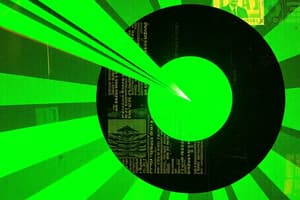Podcast
Questions and Answers
What initiates the excitation of nitrogen molecules in the gas mixture?
What initiates the excitation of nitrogen molecules in the gas mixture?
- Absorption of heat
- Vibrational energy transfer from CO₂
- Direct energy absorption by CO₂
- Electrons colliding with the nitrogen molecules (correct)
To which vibrational state do CO₂ molecules get directly promoted by electrical discharge?
To which vibrational state do CO₂ molecules get directly promoted by electrical discharge?
- (100)
- (010)
- (001) (correct)
- (020)
What is the primary method by which nitrogen transfers excitation energy to CO₂?
What is the primary method by which nitrogen transfers excitation energy to CO₂?
- Electrical discharge
- Molecular collisions (correct)
- Radiative decay
- Thermal conduction
When will CO₂ molecules primarily dissipate energy as heat rather than light?
When will CO₂ molecules primarily dissipate energy as heat rather than light?
How do helium (He) molecules affect the CO₂ laser process?
How do helium (He) molecules affect the CO₂ laser process?
What is the relationship between the length of the active medium and the output power of a CO₂ laser?
What is the relationship between the length of the active medium and the output power of a CO₂ laser?
Which of the following is NOT an advantage of CO₂ lasers?
Which of the following is NOT an advantage of CO₂ lasers?
What is a common characteristic of continuous-wave CO₂ lasers?
What is a common characteristic of continuous-wave CO₂ lasers?
What type of vibration occurs when the carbon atom remains stationary while both oxygen atoms move simultaneously?
What type of vibration occurs when the carbon atom remains stationary while both oxygen atoms move simultaneously?
Which gases are typically found in the active medium of a CO2 laser?
Which gases are typically found in the active medium of a CO2 laser?
What role does nitrogen play in the CO2 laser system?
What role does nitrogen play in the CO2 laser system?
What physical processes occur in the energy-level diagram of a CO2 laser?
What physical processes occur in the energy-level diagram of a CO2 laser?
How does the presence of other molecules enhance the pumping efficiency of a CO2 laser?
How does the presence of other molecules enhance the pumping efficiency of a CO2 laser?
What is the output characteristic of a CO2 laser?
What is the output characteristic of a CO2 laser?
What distinguishes molecular lasers, like the CO2 laser, from atomic and ionic lasers?
What distinguishes molecular lasers, like the CO2 laser, from atomic and ionic lasers?
Which component in a CO2 laser system is responsible for achieving population inversion?
Which component in a CO2 laser system is responsible for achieving population inversion?
What is the effect of oxygen in the CO2 laser mixture?
What is the effect of oxygen in the CO2 laser mixture?
Which vibration mode involves the carbon atom moving along the axis of the CO2 molecule?
Which vibration mode involves the carbon atom moving along the axis of the CO2 molecule?
What condition is critical for achieving consistent performance in a CO2 laser?
What condition is critical for achieving consistent performance in a CO2 laser?
Which of the following is a disadvantage of CO2 lasers?
Which of the following is a disadvantage of CO2 lasers?
What type of radiation do CO2 lasers emit?
What type of radiation do CO2 lasers emit?
What is the main risk associated with accidental exposure to CO2 lasers?
What is the main risk associated with accidental exposure to CO2 lasers?
What does the v₂ vibrational mode represent in a CO2 molecule?
What does the v₂ vibrational mode represent in a CO2 molecule?
What is the ground state vibrational energy level for CO2 molecules?
What is the ground state vibrational energy level for CO2 molecules?
Flashcards
CO2 Laser Type
CO2 Laser Type
CO2 lasers belong to the molecular gas laser family. They use the energy transitions in CO2 molecules to generate laser light.
What are the Vibrational Modes of CO2?
What are the Vibrational Modes of CO2?
CO2 molecules vibrate in three ways: Symmetric Stretching, Bending, and Asymmetric Stretching. These modes involve the movement of oxygen and carbon atoms.
Active Medium of CO2 Laser
Active Medium of CO2 Laser
The active medium is a mix of CO2, N2, and He (or water vapor). When electricity excites the gas, the molecules become energized for lasing.
What is the role of N2 in a CO2 laser?
What is the role of N2 in a CO2 laser?
Signup and view all the flashcards
CO2 Laser Power Output
CO2 Laser Power Output
Signup and view all the flashcards
What makes CO2 molecule energy levels complex?
What makes CO2 molecule energy levels complex?
Signup and view all the flashcards
Population Inversion in CO2 Laser
Population Inversion in CO2 Laser
Signup and view all the flashcards
Optical Resonators in CO2 Laser
Optical Resonators in CO2 Laser
Signup and view all the flashcards
CO₂ Laser Excitation
CO₂ Laser Excitation
Signup and view all the flashcards
CO₂ Laser Energy Levels
CO₂ Laser Energy Levels
Signup and view all the flashcards
Laser Light Emission
Laser Light Emission
Signup and view all the flashcards
Helium's Role
Helium's Role
Signup and view all the flashcards
Continuous-Wave CO₂ Laser
Continuous-Wave CO₂ Laser
Signup and view all the flashcards
CO₂ Laser Efficiency
CO₂ Laser Efficiency
Signup and view all the flashcards
CO₂ Laser Output Power
CO₂ Laser Output Power
Signup and view all the flashcards
Advantages of CO₂ Laser
Advantages of CO₂ Laser
Signup and view all the flashcards
CO2 Laser Power Adjustment
CO2 Laser Power Adjustment
Signup and view all the flashcards
CO2 Laser Contamination
CO2 Laser Contamination
Signup and view all the flashcards
CO2 Laser Temperature Sensitivity
CO2 Laser Temperature Sensitivity
Signup and view all the flashcards
CO2 Laser Mirror Corrosion
CO2 Laser Mirror Corrosion
Signup and view all the flashcards
CO2 Laser Eye Safety
CO2 Laser Eye Safety
Signup and view all the flashcards
What are the vibrational modes of a CO2 molecule?
What are the vibrational modes of a CO2 molecule?
Signup and view all the flashcards
What is the symmetric stretching mode (v₁) in a CO2 molecule?
What is the symmetric stretching mode (v₁) in a CO2 molecule?
Signup and view all the flashcards
What is the bending mode (v₂) in a CO2 molecule?
What is the bending mode (v₂) in a CO2 molecule?
Signup and view all the flashcards
Study Notes
Types of Lasers
- Carbon dioxide (CO2) lasers are molecular gas lasers
- Electrons in molecules can be excited to higher energy levels, defining the electronic state of the molecule
- Molecules have other energy levels besides electronic levels
- Carbon dioxide (CO2) is a symmetric molecule (O=C=O) with three modes of vibration
Vibrational Modes of Carbon Dioxide
- Symmetric vibration: Carbon atom stationary, oxygen atoms move simultaneously along the molecular axis (0.172 eV)
- Bending vibration: Oxygen and carbon atoms vibrate perpendicular to the molecular axis (0.083 eV)
- Asymmetric vibration: Oxygen and carbon atoms oscillate asymmetrically, with oxygen moving in one direction while carbon moves in the opposite (0.291 eV)
Active Medium
- Mixture of CO2, N2, and He or water vapor
Optical Resonators
- Pair of concave mirrors on either side of the discharge tube
- One mirror is completely polished, the other partially polished
Population Inversion
- Achieved through applying an electric discharge to the gas mixture
- Electron collisions excite CO2 molecules to higher electronic, vibrational, and rotational energy levels
- Radiationless transitions populate higher levels
- Presence of other molecules (like N2) facilitates resonant energy transfer, enhancing pumping efficiency
- Nitrogen acts like helium in a He-Ne laser
Carbon Dioxide Laser Characteristics
- Generates continuous laser beam with high power output (kilowatts) and high spectral purity and spatial coherence
- Energy level structure more complex compared to atoms/ions (electronic, vibrational, rotational motions)
Energy-Level Diagram
- Illustrates vibrational-rotational states and physical processes in the laser
- Electric discharge excites nitrogen molecules, transferring enough energy to excite them to their first vibrational-rotational energy level (4(001))
- Majority of electrical discharge energy absorbed by nitrogen molecules; small fraction absorbed by CO2 molecules to excite them from (000) to (001)
- Energy transfer occurs between N2 and CO2 molecules, further populating excited vibrational states in CO2
Energy Release and Laser Emission
- Excited CO2 molecules release energy and transition to lower vibrational states (e.g., (100), (020))
- Energy release corresponds to laser light emission at frequencies of 10.6 μm or 9.6 μm
- Residual decay transitions (from (100) to (010), (020) to (010), (010) to (000)) primarily dissipate as heat, not light
Additional Characteristics
- Population of the fourth energy level in CO2 is increased by the presence of He molecules, which helps depopulate lower laser levels
- Output power of a CO2 laser is directly proportional to the length of the active medium
- Continuous-wave (CW) CO2 lasers with low power outputs (up to 50 W) are often sealed tube configurations
Advantages of CO2 Laser
- Simple construction
- Continuous wave (CW) output for applications requiring steady laser beams
- High efficiency (significant electrical input converted to laser output)
- High output power beneficial for industrial and medical applications
- Scalable power output (length of the discharge tube adjusted for greater control over power levels)
Disadvantages of CO2 Laser
- Contamination effects (presence of oxygen can form CO, affecting efficiency)
- Temperature sensitivity (operating temperature significantly influences output power; optimal temperature critical for consistent performance)
- Corrosion of reflecting plates (mirrors, particularly high-reflectivity ones, can corrode over time).
- Risk of eye damage (infrared radiation, invisible to the naked eye, can cause serious eye damage without warning)
Vibrational Energy Modes (CO2)
- V1: Symmetric stretching
- V2: Bending
- V3: Asymmetric stretching
- Each mode corresponds to a vibrational energy level within the CO2 molecule
Studying That Suits You
Use AI to generate personalized quizzes and flashcards to suit your learning preferences.




